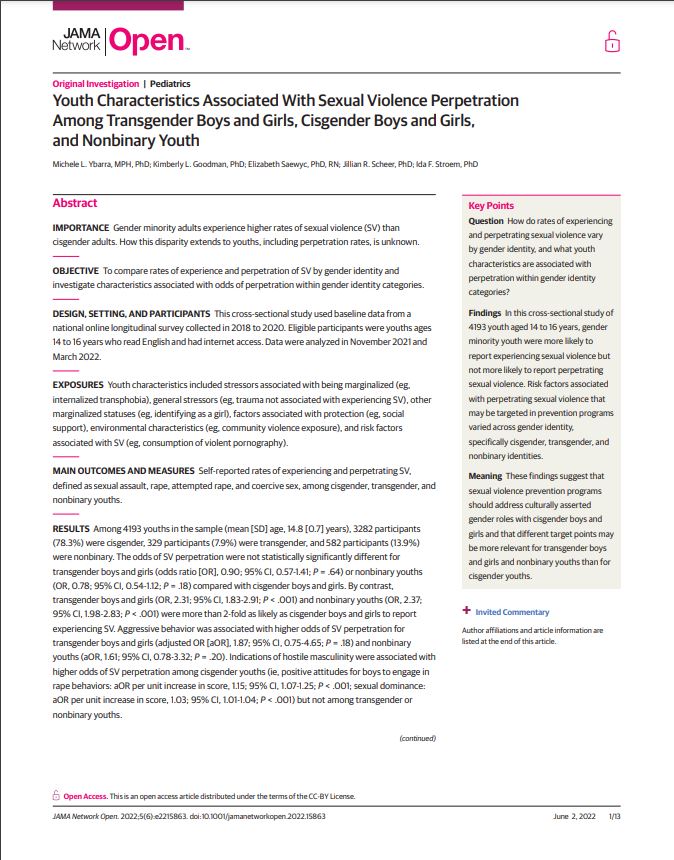Child-on-child (Peer-on-peer) Sexual Abuse
Youth Characteristics Associated With Sexual Violence Perpetration Among Transgender Boys and Girls, Cisgender Boys and Girls, and Nonbinary Youth
 Full Article Title: Youth Characteristics Associated With Sexual Violence Perpetration Among Transgender Boys and Girls, Cisgender Boys and Girls, and Nonbinary Youth.
Full Article Title: Youth Characteristics Associated With Sexual Violence Perpetration Among Transgender Boys and Girls, Cisgender Boys and Girls, and Nonbinary Youth.
Open Access: Yes
Abstract
IMPORTANCE Gender minority adults experience higher rates of sexual violence (SV) than cisgender adults. How this disparity extends to youths, including perpetration rates, is unknown.
OBJECTIVE To compare rates of experience and perpetration of SV by gender identity and investigate characteristics associated with odds of perpetration within gender identity categories.
DESIGN, SETTING, AND PARTICIPANTS This cross-sectional study used baseline data from a national online longitudinal survey collected in 2018 to 2020. Eligible participants were youths ages
14 to 16 years who read English and had internet access. Data were analyzed in November 2021 and March 2022.
EXPOSURES Youth characteristics included stressors associated with being marginalized (eg, internalized transphobia), general stressors (eg, trauma not associated with experiencing SV), other marginalized statuses (eg, identifying as a girl), factors associated with protection (eg, social support), environmental characteristics (eg, community violence exposure), and risk factors associated with SV (eg, consumption of violent pornography).
MAIN OUTCOMES AND MEASURES Self-reported rates of experiencing and perpetrating SV, defined as sexual assault, rape, attempted rape, and coercive sex, among cisgender, transgender, and nonbinary youths.
RESULTS Among 4193 youths in the sample (mean [SD] age, 14.8 [0.7] years), 3282 participants (78.3%) were cisgender, 329 participants (7.9%) were transgender, and 582 participants (13.9%) were nonbinary. The odds of SV perpetration were not statistically significantly different for transgender boys and girls (odds ratio [OR], 0.90; 95% CI, 0.57-1.41; P = .64) or nonbinary youths (OR, 0.78; 95% CI, 0.54-1.12; P = .18) compared with cisgender boys and girls. By contrast, transgender boys and girls (OR, 2.31; 95% CI, 1.83-2.91; P < .001) and nonbinary youths (OR, 2.37; 95% CI, 1.98-2.83; P < .001) were more than 2-fold as likely as cisgender boys and girls to report experiencing SV. Aggressive behavior was associated with higher odds of SV perpetration for transgender boys and girls (adjusted OR [aOR], 1.87; 95% CI, 0.75-4.65; P = .18) and nonbinary youths (aOR, 1.61; 95% CI, 0.78-3.32; P = .20). Indications of hostile masculinity were associated with higher odds of SV perpetration among cisgender youths (ie, positive attitudes for boys to engage in rape behaviors: aOR per unit increase in score, 1.15; 95% CI, 1.07-1.25; P < .001; sexual dominance: aOR per unit increase in score, 1.03; 95% CI, 1.01-1.04; P < .001) but not among transgender or nonbinary youths.
CONCLUSION AND RELEVANCE These findings may suggest an important foundation for the development of inclusive, research-based SV prevention programs and methods for incorporating gender identity effectively into SV research.
Relevance
Both cisgender boys and nonbinary youths who reported past-year exposure to violent pornography or nonviolent pornography were more likely than those not exposed to pornography to report perpetuating sexual violence.
Citation
Ybarra, M. L., Goodman, K. L., Saewyc, E., Scheer, J. R., & Stroem, I. F. (2022). Youth Characteristics Associated With Sexual Violence Perpetration Among Transgender Boys and Girls, Cisgender Boys and Girls, and Nonbinary Youth. JAMA Network Open, 5(6), Article e2215863. doi:10.1001/jamanetworkopen.2022.15863
